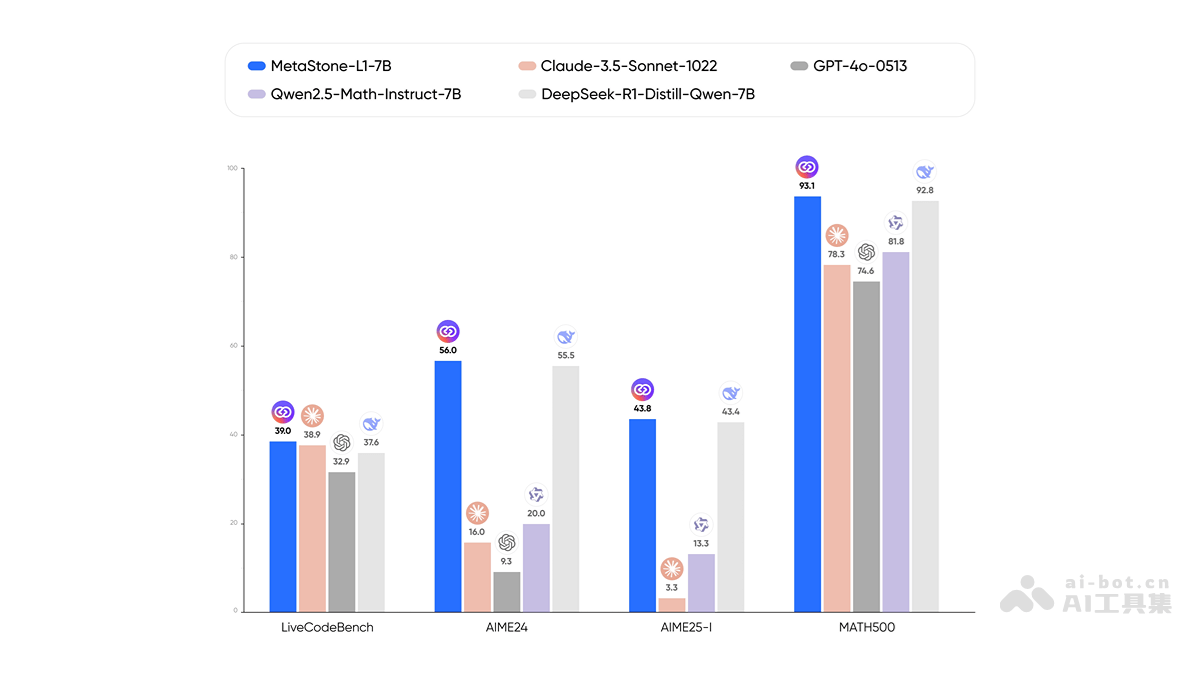MetaStone-L1-7B
MetaStone-L1-7B is a lightweight inference model designed to enhance performance in complex downstream tasks, achieving top-tier results in core reasoning benchmarks like mathematics and coding.
What is MetaStone-L1-7B?
MetaStone-L1-7B is a lightweight inference model from the MetaStone series, designed to enhance performance in complex downstream tasks. It achieves state-of-the-art (SOTA) results in core reasoning benchmarks such as mathematics and coding, comparable to API models like Claude-3.5-Sonnet-1022 and GPT4o-0513. The model is trained by GRPO based on DeepSeek-R1-Distill-Qwen-7B.
Key Features of MetaStone-L1-7B
- Powerful Reasoning Ability: Achieves top-tier results in core reasoning benchmarks like mathematics and coding, comparable to API models such as Claude-3.5-Sonnet-1022 and GPT4o-0513.
- Optimized Training Foundation: Trained by GRPO based on DeepSeek-R1-Distill-Qwen-7B, ensuring a solid performance foundation.
- Flexible Usage Settings: Recommended settings include a temperature of 0.6, top-p sampling probability of 0.95, and a maximum generation length of 32k for optimal performance.
- Optimized Prompts for Specific Problems: For math problems, add the prompt
Please reason step by step, and put your final answer within \boxed{}. For coding problems, specific format requirements can further enhance the model's reasoning effectiveness.
Technical Principles of MetaStone-L1-7B
- DeepSeek-R1 Based Architecture: MetaStone-L1-7B is trained by GRPO based on DeepSeek-R1-Distill-Qwen-7B. DeepSeek-R1 uses advanced Visual Fine-Tuning (V-FT) technology, significantly improving the model's visual understanding and multimodal alignment through cross-modal contrastive learning, gradient decoupling training, and attention gating mechanisms.
- Cross-Architecture Computing Cluster Support: MetaStone proposes a RISC-V & x86 cross-architecture computing cluster solution, compatible with various CPU chip architectures including RISC-V and x86. This allows MetaStone-L1-7B to run efficiently on different architecture resources, leveraging the performance advantages of different CPU architectures.
- Cloud-Native Technology Application: MetaStone innovatively proposes the "MetaStone CloudOS" based on cloud-native technology, providing applications with full cloud infrastructure capabilities from containers, virtualization, storage, network, to security. MetaStone CloudOS breaks the barriers in resource scheduling between RISC-V architecture clusters and x86/ARM architecture clusters, enabling true cross-architecture computing power flow.
- Low Parameter Count and High Efficiency Design: MetaStone-L1-7B achieves the image-text understanding capabilities of traditional multimodal models (like Flamingo-80B) with only 7B parameters. This low parameter count design reduces computational resource requirements, further enhancing training efficiency through mixed-precision training and gradient checkpointing techniques.
Project Address of MetaStone-L1-7B
- HuggingFace Model Repository: https://huggingface.co/MetaStoneTec/MetaStone-L1-7B
Application Scenarios of MetaStone-L1-7B
- Math Problem Solving: Can reason step-by-step to solve complex math problems, such as completing squares or solving equations. Users only need to input the problem, and the model will reason step-by-step and provide the final answer in a specific format (e.g.,
\boxed{}), making it easy for students to understand and learn. - Programming Assistance: For programming problems, the model can generate code that meets specific requirements and outputs it in a specified format. For example, users can ask the model to read input, solve the problem, and write the answer to the output, and the model will generate the corresponding code snippet.
- Intelligent Customer Service: Can quickly and accurately answer user questions, providing solutions and suggestions to improve the efficiency and quality of customer service.
- Content Creation: Helps users generate text content, such as articles, stories, and poems, inspiring creativity.
- Code Generation and Optimization: Generates code snippets based on user requirements, helping developers quickly implement features and improve development efficiency.
Features & Capabilities
Categories
AI
Inference Model
Machine Learning
Getting Started
Screenshots & Images
Additional Images

Stats
117
Views
0
Favorites

